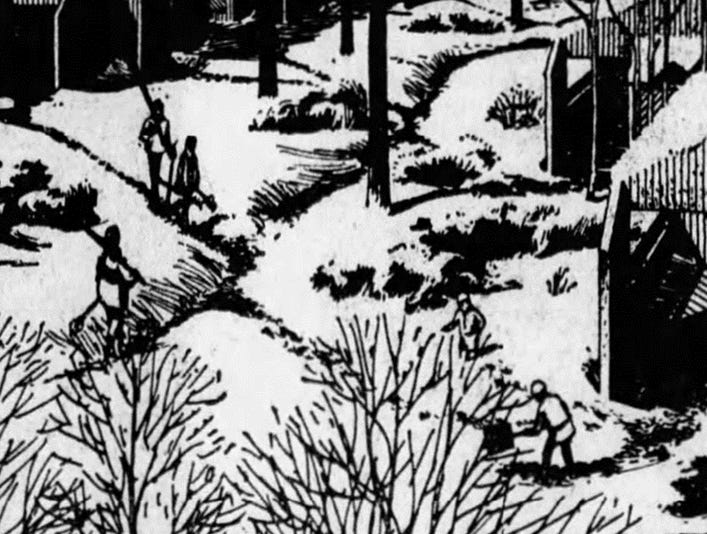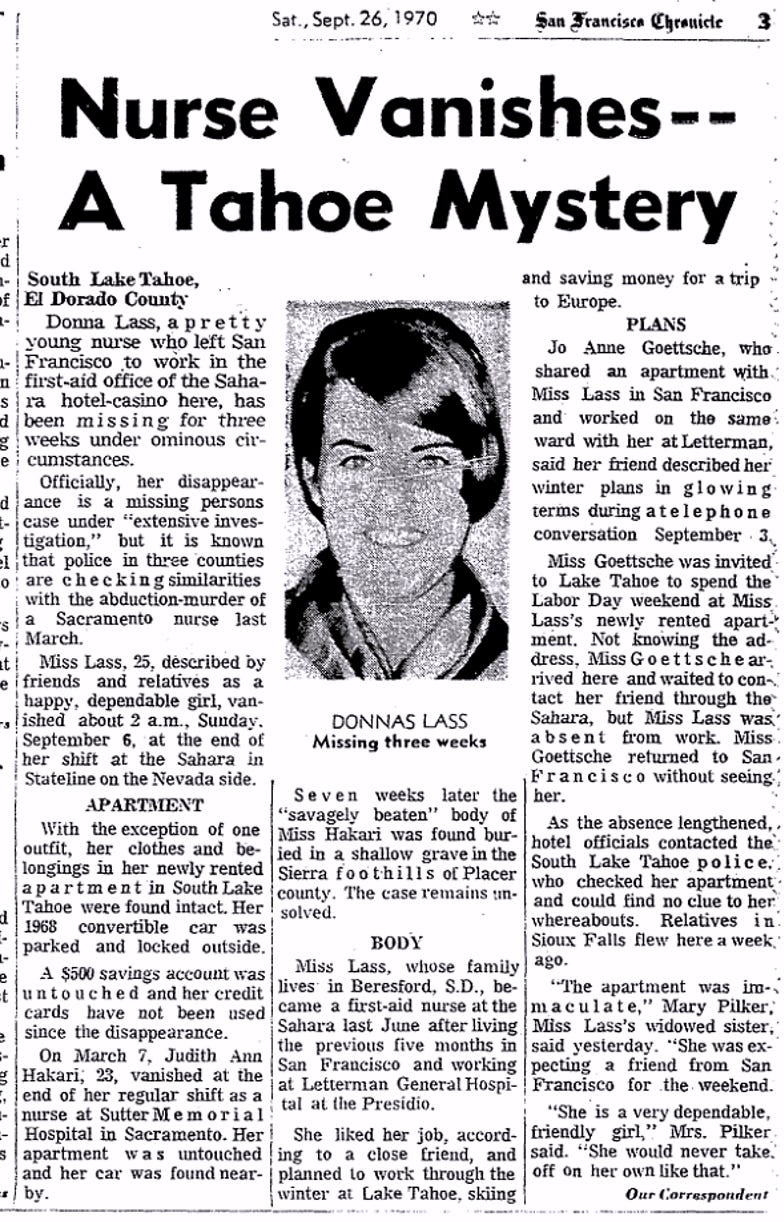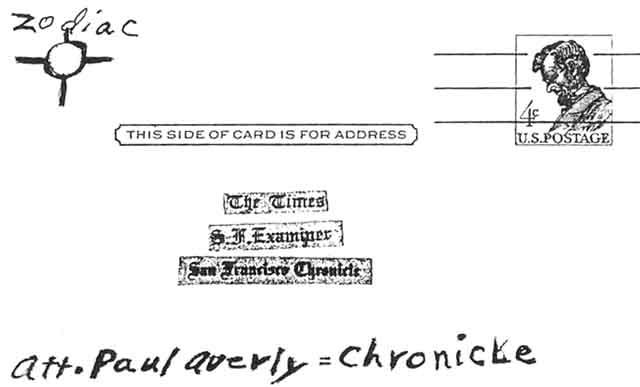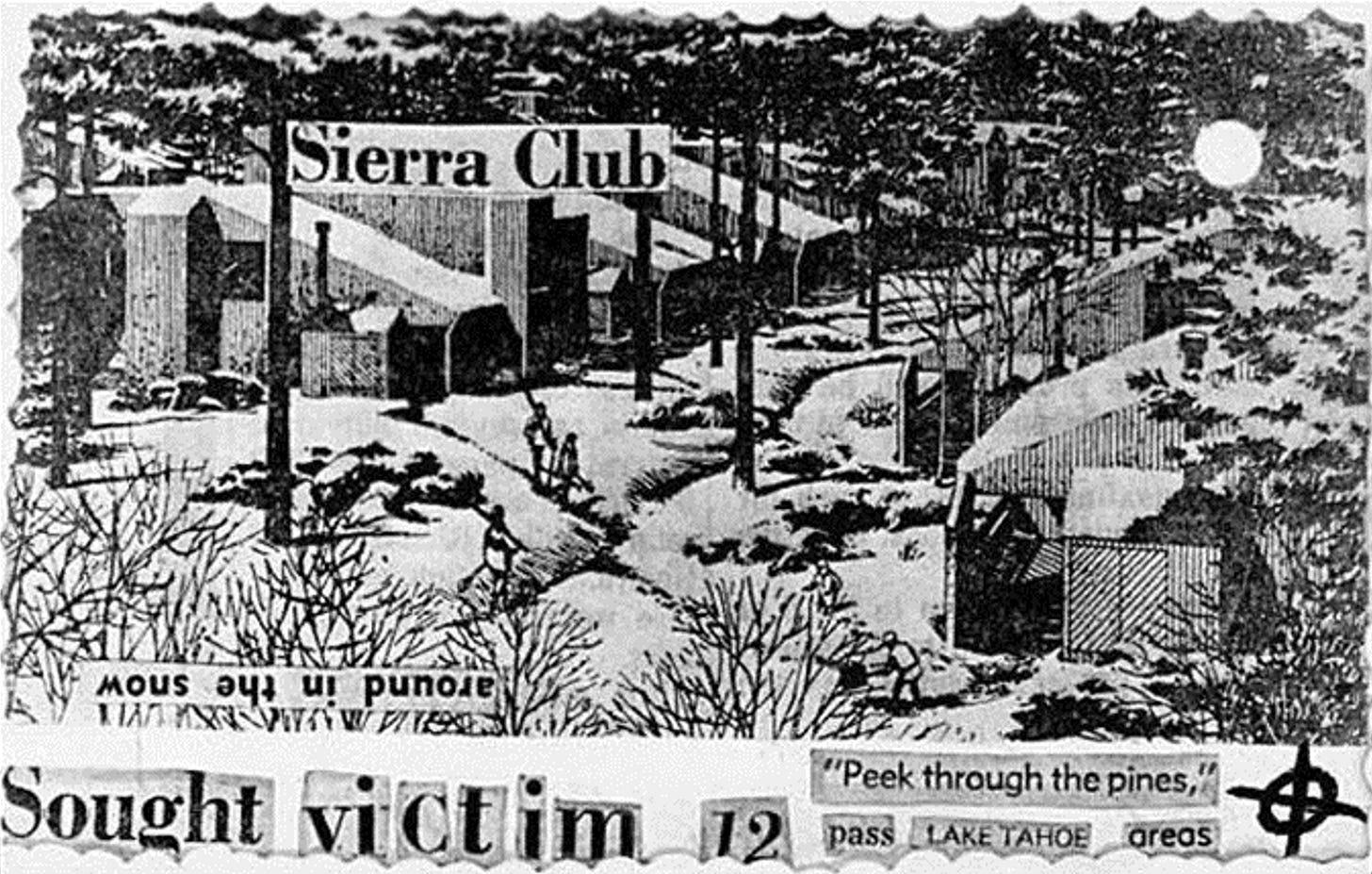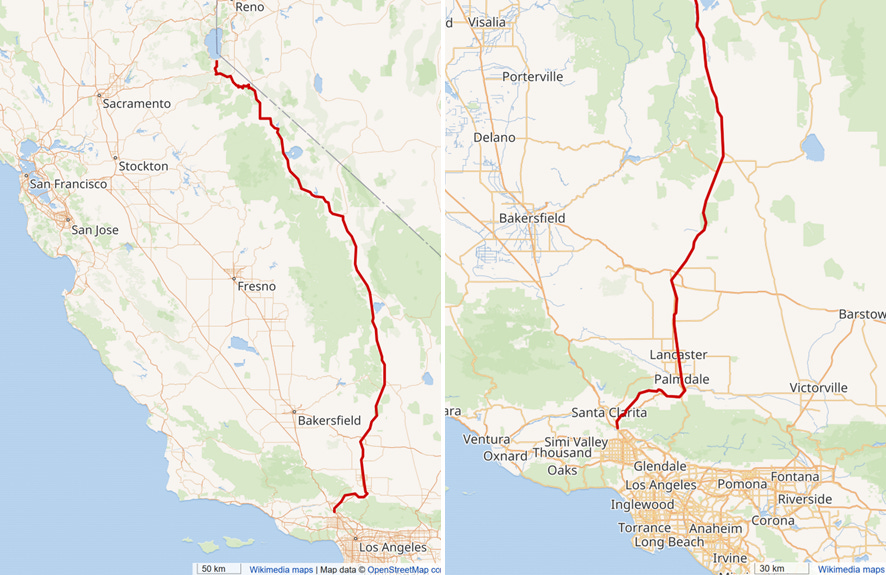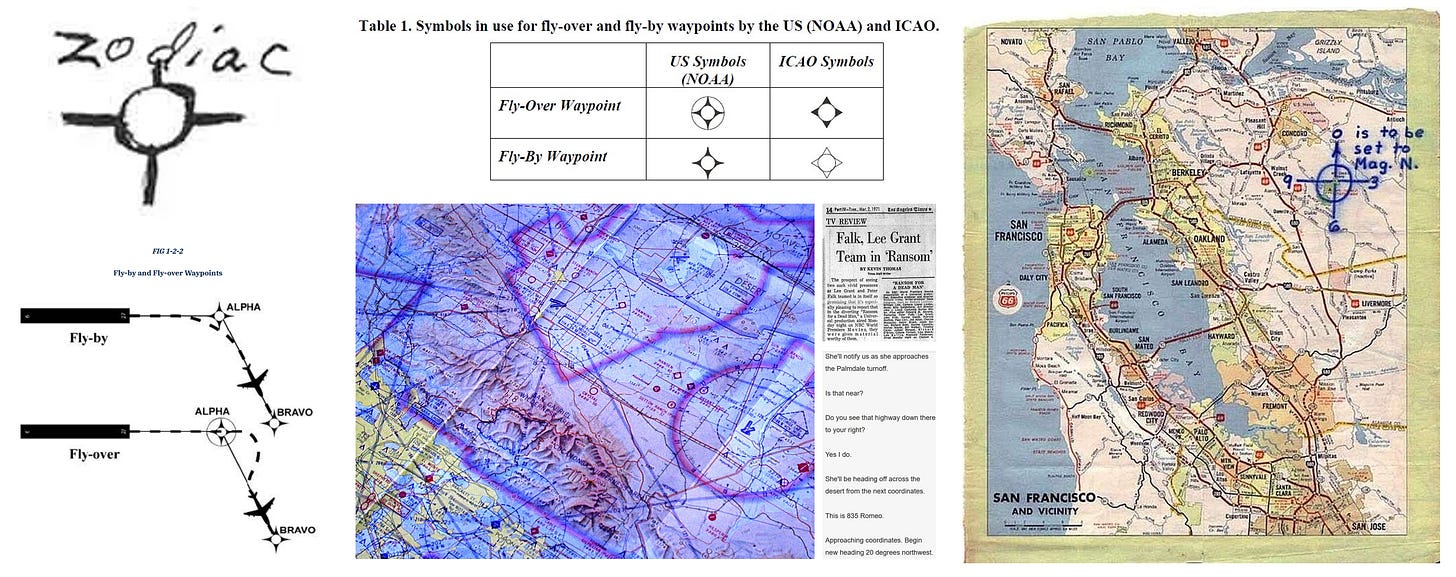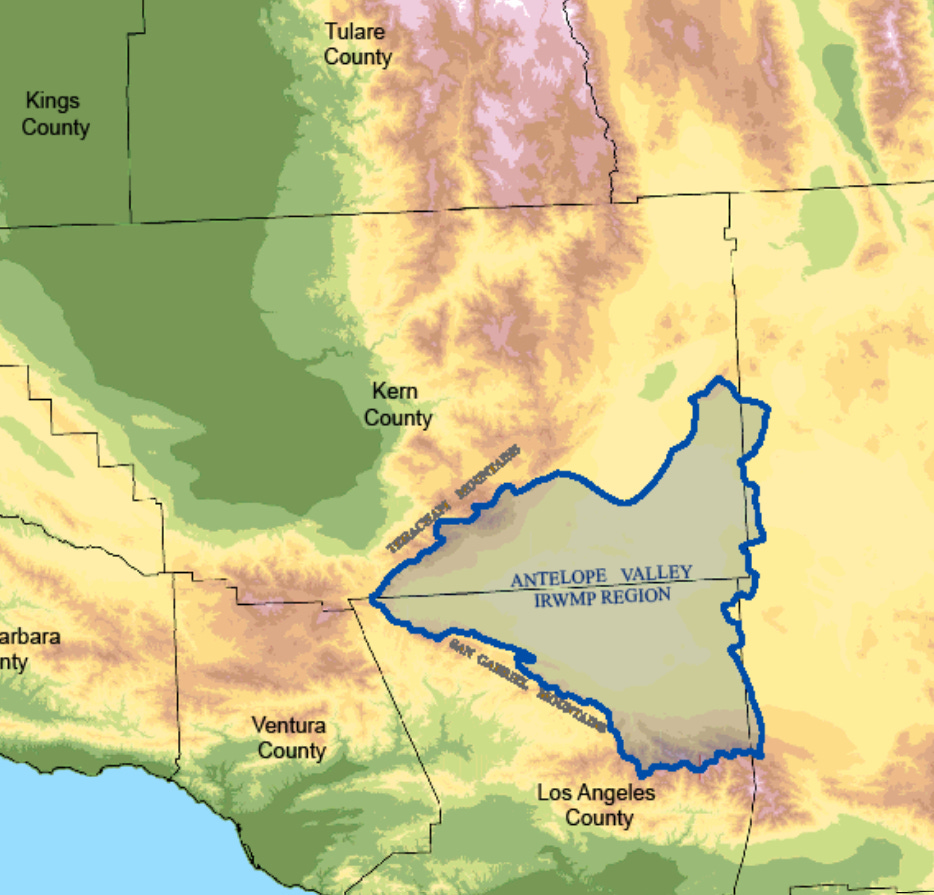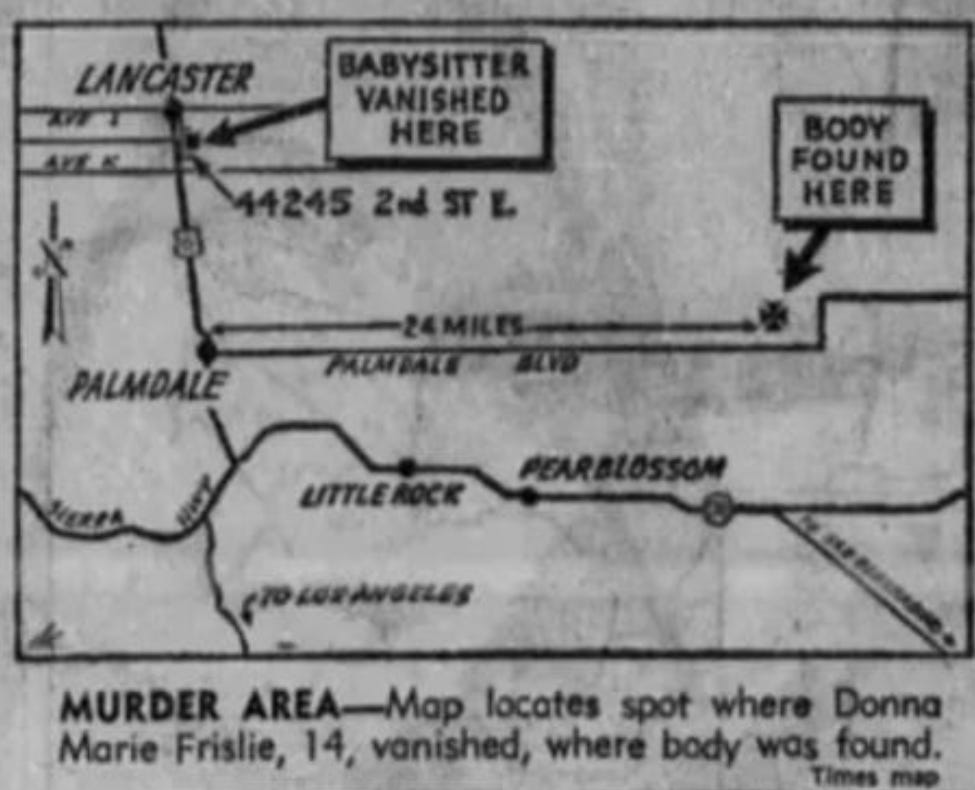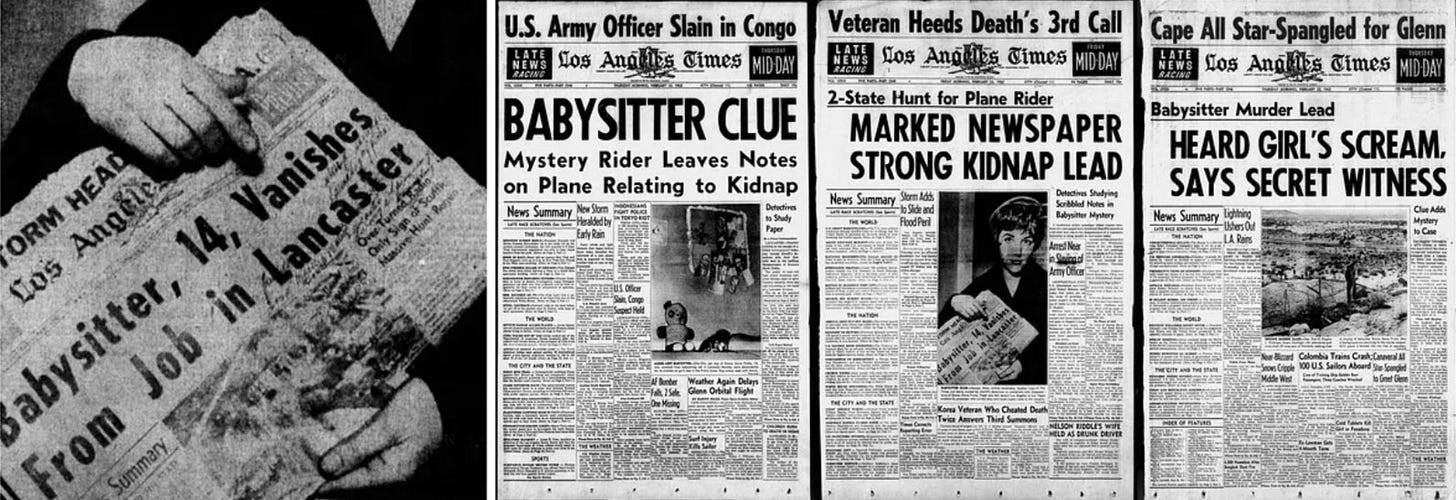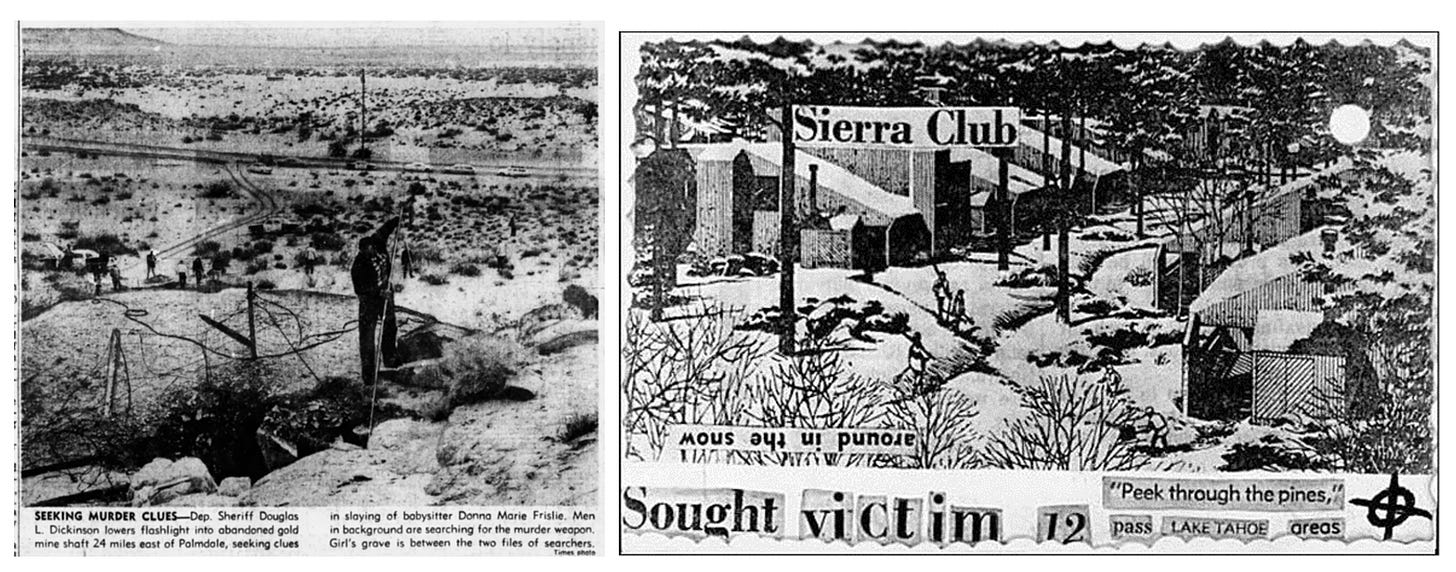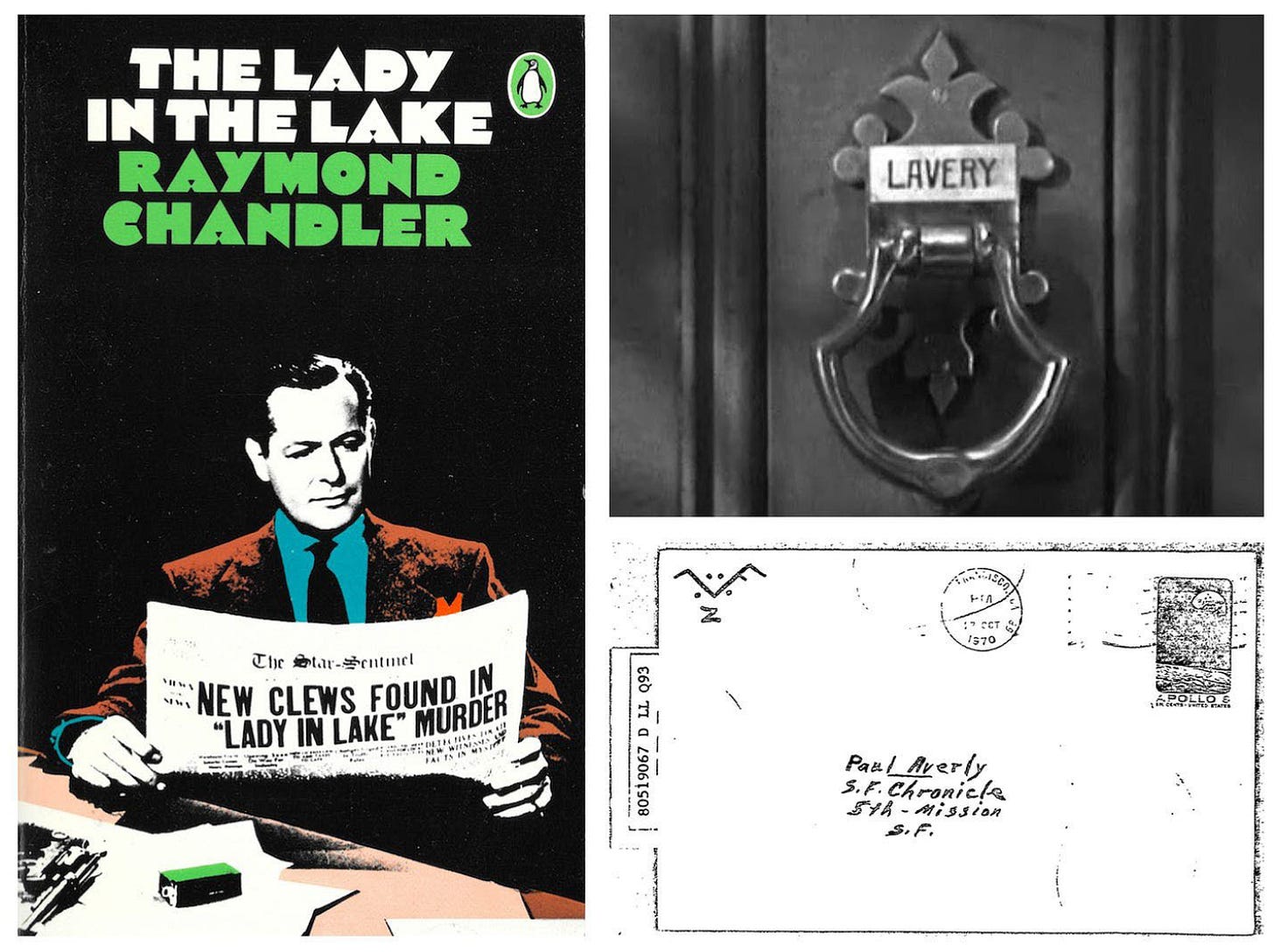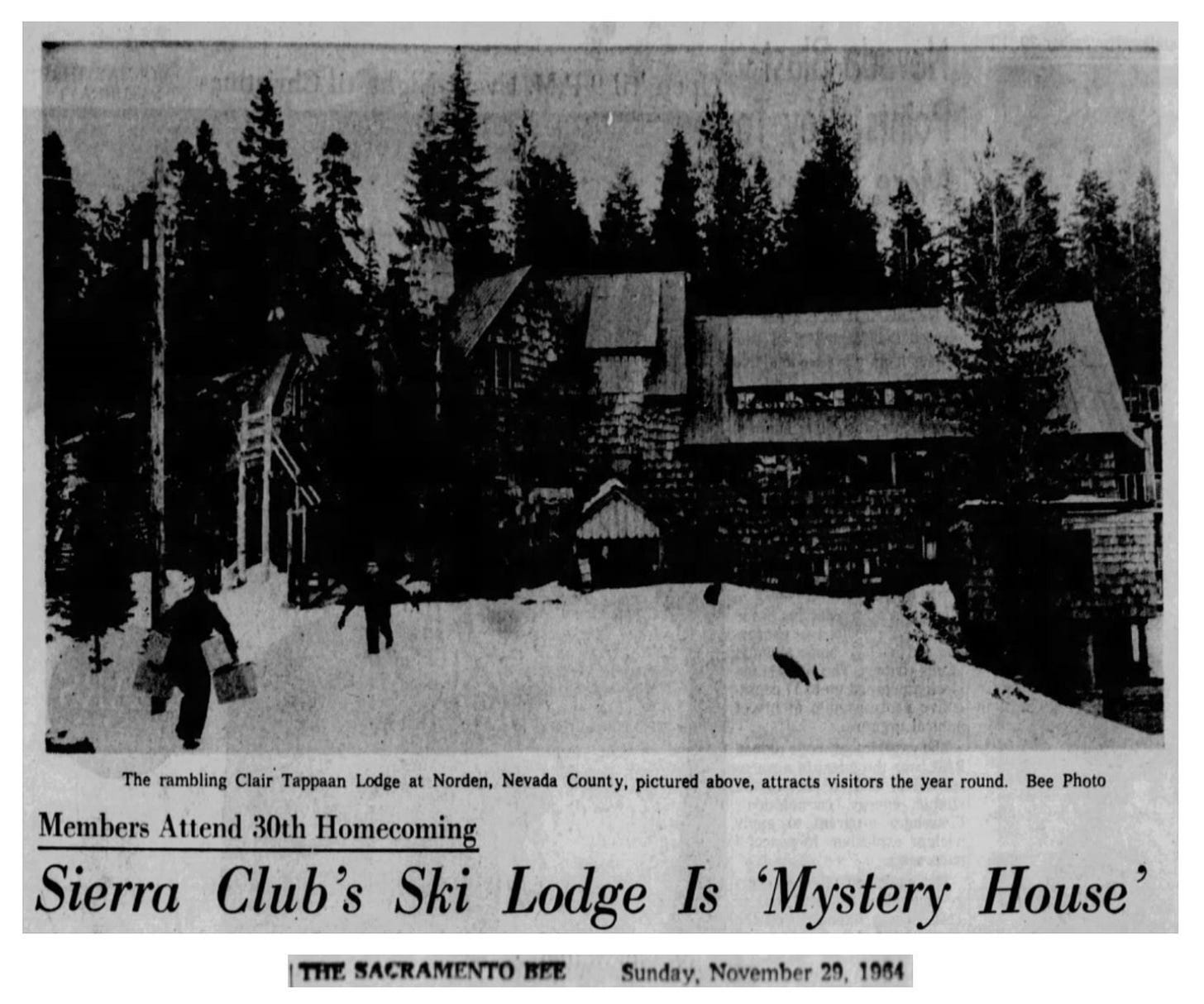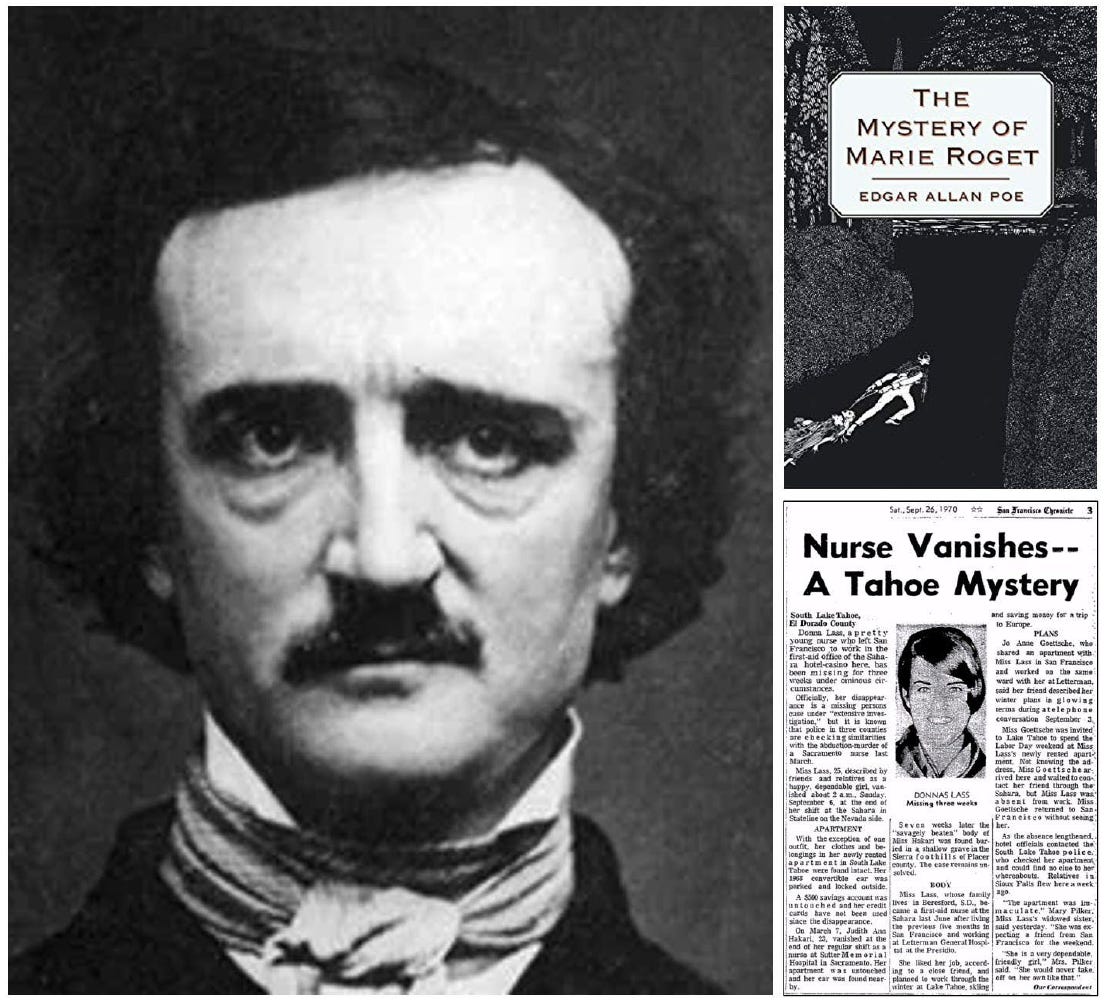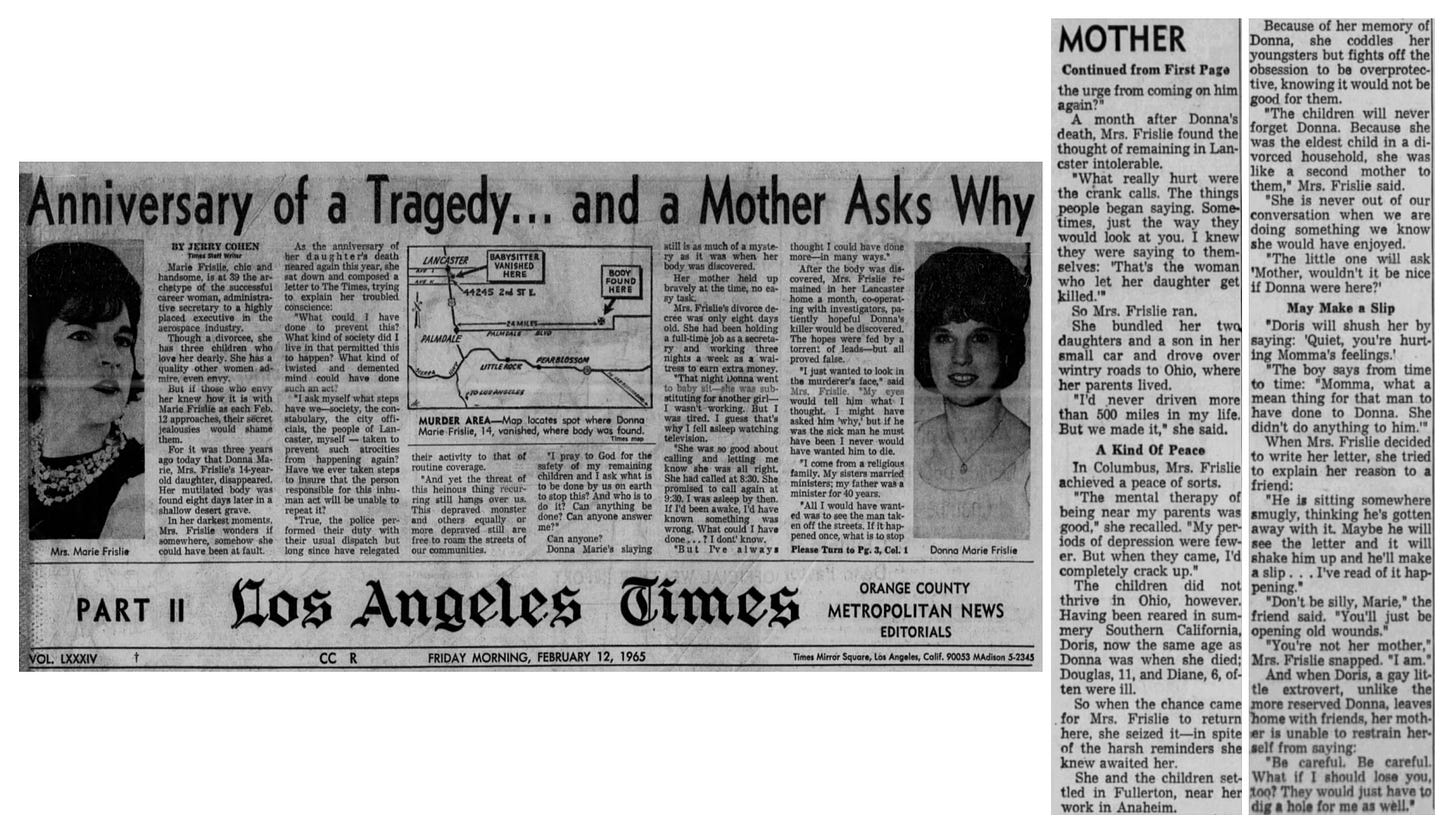Five Easy Pieces - Part III [Updated 10/5]
The Pines Card is Another Hint That George Hodel Murdered Donna Marie Frislie
In retrospect, it sure looks like the Zodiac’s Pines Card of March 22, 1971 was a hint at his authorship of Donna Frislie’s murder “down there” in LA. That is not how it was viewed at the time, though. Per contemporary press reports, the police suspected that Zodiac was claiming to be behind the presumed murder of Donna Lass, a first aid nurse at the Sahara Tahoe casino on Lake Tahoe’s South Shore. Lass’s disappearance on September 6, 1970 received a big write-up as “Nurse Vanishes — A Tahoe Mystery” in the Zodiac’s favorite newspaper, the San Francisco Chronicle, on September 26, 1970.
The Pines Card, it was theorized, was a visual puzzle which hinted at the location of Donna Lass’s body. The evidence for this idea was the fact that the card incorporated artwork clipped from a recent newspaper ad for a new condominium development on Tahoe’s North Shore, and one of the text hints pasted around this drawing references “Lake Tahoe areas” — taken in context with the circumstance that (presumably) the Lass disappearance was the most recent suspected murder absent a corpus delecti in Lake Tahoe. There was nothing to link Zodiac to the Tahoe area, however, and none of the Zodiac’s known crimes had involved a kidnapping or the hiding of a body, nor would Zodiac ever overtly claim responsibility for Lass’s murder.
In fact, the police were unable to extract any useful ideas about the Lass case from the Pines Card. Over the next five decades a number of parties claimed to have developed actionable clues to the location of Donna Lass’s grave by analyzing the hints in the card, but none of these theories led to a break in the case. Finally, in December of last year, Placer County police announced that a skull found on the Interstate 80 corridor between Lake Tahoe and Sacramento in 1986 had recently been definitively linked to the missing nurse using advanced DNA forensics. The location of this 1986 find was unrelated to locations theorists proposed based on exegesis of the Pines Card.
Several months before the recent breakthrough I proposed an alternative reading of the Pines Card, under which its reference to the Donna Lass case was intended but secondary to the real payload of the communication. It postulates that the Zodiac read the “Tahoe Mystery” article in the SF Chronicle and that inspired him to put together another of the clue-laden puzzles which were his stock-in-trade, fully expecting his audience to get stuck on the Donna Lass angle and miss the point. The all-important context under this analysis is that the Pines Card was a direct followup to Zodiac’s Los Angeles Times Letter of March 13, 1971. In the letter to the Times Zodiac acknowledged his authorship of the 1966 murder of 18-yo cheerleader Cheri Jo Bates in the Inland Empire city of Riverside, CA:
This is the Zodiac speaking Like I have allways said, I am crack proof. If the Blue Meannies are evere going to catch me, they had best get off their fat asses + do something. Because the longer they fiddle + fart around, the more slaves I will collect for my after life. I do have to give them credit for stumbling across my riverside activity, but they are only finding the easy ones, there are a hell of a lot more down there. The reason I'm writing to the Times is this, They don't bury me on the back pages like some of the others
Not only was this letter the first and only time that Zodiac wrote directly to the Los Angeles Times, but the Pines Card was itself co-addressed to the paper, even though it was marked to the personal attention of the San Francisco Chronicle’s Paul Avery and was delivered to his employer up north. Indeed, the Los Angeles Times was called out first in the address area of the Pines Card — in a coyly understated fashion, using a generic-looking “The Times” logo, probably clipped from a Sunday edition.
My idea, then, is that the Pines Card was actually a taunting clue to Zodiac’s identity — in the sense of the historical, high-profile crimes he had gotten away with — rather than a brag about a current case. More specifically, it is a clue about a murder “down there” in the LA area. The question becomes: aside from dangling a red herring about the Chronicle’s “Tahoe Mystery,” how do references to Lake Tahoe fit into a hint about a crime “down there?” I believe the answer to that is pretty obvious, once you try out “the unsolved Donna Frislie case” as the solution to the puzzle.
The Pines Card art depicts a condo development at Incline Village on the North Shore of Lake Tahoe. A row of condos with visually striking inclined roofs recedes into the distance, and we can make out at least a couple of buildings facing them on the other side of a long trail flanked by pines. In a spot corresponding to the far distance there is a punch hole, apparently on the trail. If we flip the card over, the hole corresponds to a defaced Zodiac cross-hair signature — a circle with projecting compass points. In the foreground there is an open area where the rank of condos ends, and there are figures carrying skis. We see a stooped man at the lower right of this open area who seems to be digging by a side path which juts out at right angles to the main trail.1
Turning to the paste-up text, we have a label near the top of the picture which says, “Sierra Club.” It is ambiguous whether this is a general title for the tableau or only tags a specific feature such as a particular building. Per Merriam-Webster, the word sierra means: (a), a range of mountains, especially with a serrated or irregular outline or, (b), the country about a sierra. Lake Tahoe itself lies within the northern reaches of the Sierra Nevada — the “snowy, jagged” mountain range that extends up the eastern side of California. The Sierra Club is a storied environmental lobby founded in San Francisco in 1892 for the purpose of protecting the Sierra Nevada wilderness.
Pasted upside-down at the lower left of the Incline Village scene there is the phrase, “around in the snow.” Below the condo artwork we have paste-up text saying “Sought victim 12,” “Peek through the pines,” and “pass LAKE TAHOE areas.”
Of note, Zodiac gave the entire paste-up collage serrated edges using pinking shears or by laborious application of a hole punch, perhaps to emphasize the sierra theme.
What if we try out the idea that the card is about a murder “down there” in LA? How would we square that with the Tahoe references and other proffered clues?
If we assume the card’s hints as to the location of a crime or a victim’s body are to be interpreted from the POV of the named addressee — the SF Chronicle’s Zodiac expert, Paul Avery — our starting point should be San Francisco. Then, on the theory we are being steered towards a crime scene “down there,” if we do a straight shot up I-80 towards Tahoe and then “pass LAKE TAHOE areas” — e.g., the two areas implicitly referenced in the card, Incline Village (site of the condo development) and South Lake Tahoe (scene of the Lass disappearance) — and continue “around in the snow” via the Sierra Nevada mountains, we emerge in the High Desert northeast of LA.
We might note that if we “peek through the pines” in the condo ad artwork, we see a long trail that runs beside a row of buildings with sloped roofs, reminiscent of the way the road “down there” in the California terrain map runs alongside the Sierra Nevada mountain range. Back when the Pines Card was sent, that long road was known as the Sierra Highway. This venerable highway (shown in red below) runs from South Lake Tahoe to Santa Clarita in northeast Los Angeles County. Equating the condos to the Sierra Nevada mountains and the trail running beside them to the Sierra Highway is an obvious interpretive move once you try out the “down there” theory. (It is more obvious still if you look at the Pines Card in light of Alfred Hitchcock’s Spellbound, as I believe we should — see SPECIAL TOPICS, below.)
On this interpretation, which is the “down there”end of the trail in the picture? In the distance, at top right, we have the punch hole that corresponds to a defaced Zodiac symbol on the obverse of the card. In the foreground, we have that open area with the stooped man working with a shovel on a side path. As we get that this card is probably a hint about a buried body — going back to “A Tahoe Mystery” and its intimation that Donna Lass could have suffered the fate of Judith Hakari, found buried in the Sierra foothills of Placer County — that would tend to put North at the top of the drawing. This reading is buttresed by the appearance of the open area in the foreground, which looks analogous to the Mojave (immediately south of the Sierra Nevada) and is further supported by the fact that the long row of condos is to the left of the path “through the pines,” just as the Sierra Nevada range is on the west side of the Sierra Highway.
What about the “bullet hole?” It turns out the modified Zodiac symbol rendered by the hole punch resembles a symbol long used in aerial navigation for a cartographic “waypoint.” That would make sense if we think the prescribed route references Lake Tahoe only as a navigational waypoint — an idea which flows naturally enough from the “down there” assumption. The introduction of air navigation concepts recalls the Zodiac’s other “buried treasure” puzzle, the Mount Diablo Code, which incorporates directions in polar coordinates expressed relative to Magnetic North (as in aviation), using California’s Mount Diablo as a cartographic origin or waypoint.
The open area of desert that starts below the Sierra Nevada, straddling Kern County and north Los Angeles County and bordered to the south by the Sierra Pelona and San Gabriel Mountains, is called Antelope Valley.
Thus, if we have followed the “down there” theory this far, that man with the shovel might well be standing in Antelope Valley — quite possibly on a road that branches eastward from the Sierra Highway, which runs north-south through Lancaster and Palmdale, e.g., Palmdale Boulevard. It does not look like Zodiac has unambiguously spelled out a location for us — it would be astonishing if he had — but an unsolved murder in Antelope Valley should be of interest in relation to the Pines Card.
As when working a crossword puzzle, there is only so far you can go without trying out solutions that feel in-the-ballpark to see if something “clicks.” Fo us to interpret the Pines Card, we should bring knowledge about contemporary cold cases to bear on the problem — absent that, we are most likely on a hiding to nothing. That is in fact how the police approached the Pines Card when they came up with the Donna Lass theory. Only, with the benefit of hindsight, it looks like they fell for a clever head fake on the part of the Zodiac — fool’s gold, right out of The Treasure of the Sierra Madre.
I submit that the Donna Frislie case is a good prima facie fit to the hints offered up in the Pines Card once you look at the puzzle using the “down there” frame instead of the forced, too-obvious “Lake Tahoe” frame. Then, I maintain, when you delve into the details and integrate with the wider context, it “clicks” as a solution. Consider:
Here we have an unsolved murder in Antelope Valley in the right time period — in fact, just two months before the then still-unrecognized probable proto-Zodiac murder of Ray Davis in
Ocean BeachOceanside, CA.We have a victim abducted just off the Sierra Highway, and buried in the desert off Palmdale Boulevard around 24 miles directly east of the Sierra Highway.
We have the kidnap-murder of a babysitter involving a buried body, similar in key respects to the linked cases of Donna Lass and Judith Hakari recounted in the SF Chronicle’s “Tahoe Mystery” piece, while also bearing comparison to the Cheri Jo Bates murder and meshing with the “lock up your daughters” rhetoric featured in the typed confession sent to the Riverside police and press in that case.
We have a “teen” victim — 14, in fact — kidnapped shortly after midnight on the thirteenth by a killer who sought his next victim on the night of February 12, 1962.
The victim is a “lass” named Donna, and we know that Zodiac loved word play — see, for example, the pages of puns and invented words in his Little List Letter.
We have a crime that got an extraordinary amount of above-the-fold front page coverage from the Los Angeles Times — just the sort of coverage Zodiac praised that very newspaper for about a week before mailing the Pines Card.
The marginalia scrawled on a Los Angeles Times article about Frislie’s abduction by the prime suspect — a well-dressed, dark, 50-ish traveler on a Valentine’s Day flight out of LAX — told the world he was not afraid of death. The Z340 cipher, fifty years in the breaking, purports to explain why Zodiac is not afraid of death.
We find a litany of possible cryptic allusions to details of the Frislie case in the corpus of Zodiac letters: the victim’s vulnerability due to leaving her front door cracked open to peek at the driveway, the reporting indicating that she fought with her attacker and left him with a bloody groin injury, the fact that her body was found perilously quickly for the perpetrator due to torrential rains washing out her grave, and the fact her grave was spotted by two gold prospectors under circumstances uncannily like those reported by the SF Examiner the day before Zodiac sent his Dragon Card featuring two gold prospectors to the Chronicle.
The Pines Card has an eerie formal resemblance to the Los Angeles Times’ photo captioned “Seeking Murder Clues” showing a tableau of the desert crime scene including Frislie’s grave — the visual centerpiece for the paper’s last front page banner headline story devoted to her unsolved murder.2
For sure, it is a big world, chock-full of coincidences. Still, I do not see how one could look at this set of facts and circumstances without concluding I have presented at the very least a compelling new theory about the real meaning of Zodiac’s Pines Card.
SPECIAL TOPICS:
Alfred Hitchcock’s Spellbound
It has long been suspected that Zodiac’s Halloween Card of October 27, 1970 betrays the influence of Alfred Hitchcock’s 1945 thriller Spellbound. The card’s hand-painted floating eyes recall the opening shot in the Dali dream sequence which, subjected to psychoanalytic interpretation, reveals a murder in a mountain ski resort. Since this card was sent only a month after the “Tahoe Mystery” story, it is natural to ask if the eyes heralded a reverie that would only reach its conclusion in the Pines Card of the following March. Indeed, several elements from the dream sequence have echoes in the Pines Card — a girl in a casino, ragged edges cut with scissors, the “21 Club” clue, the inclined roofs symbolizing mountain slopes, and Hitchcock’s “peek through the pines” dolly shot linking tracks in the snow to a suppressed memory of the ski resort. Spellbound was a George Hodel favorite, and it is easy enough to see why. More here.
Raymond Chandler’s The Lady in the Lake
While I have little doubt that Spellbound exerted a deep influence on the genesis of the Pines Card, a more speculative case can be made that Zodiac was also paying homage to Raymond Chandler’s 1943 detective novel, The Lady in the Lake — or stealing from Chandler, or trying to out-do him, depending how you look at it. This Philip Marlowe tale revolves around the discovery of a murdered woman’s badly decomposed body in a mountain resort northeast of LA (“Little Fawn Lake,” standing in for the real-life Big Bear Lake). Chandler throws his readers a serious curve-ball regarding the murder victim — conceivably an inspiration for the Pines Card bait-and-switch. More here.
The Clair Tappaan Lodge
An often-repeated theory about the Pines Card is that the paste-up text “Sierra Club” might be a reference to the Clair Tappaan Lodge. This is a hostel that was built as a ski lodge by Sierra Club members at UC (University of California) back in the 1930s. It lies about a half hour’s drive east of Tahoe on the Donner Pass Road, an old mountain road that runs parallel to the I-80. And, yes, one reason people have credited this idea is Zodiac’s penchant for word play: “Donner Pass” rhymes wth “Donner Lass” and we have another cryptic hint that says “pass LAKE TAHOE areas.” The Lodge theory was taken seriously by the police but proved of no value in solving the case. More here.
Edgar Allan Poe’s The Mystery of Marie Rogêt
The Zodiac tendered two “buried treasure” puzzles: the Mount Diablo Code and the Pines Card. It is quite evident that the Mount Diablo Code was inspired by Edgar Allan Poe’s short story, The Gold-Bug. It seems possible that the Pines Card is in part an homage to Poe’s The Mystery of Marie Rogêt. More here.
[ADDED 29-SEP-2024]
The digging man does not get enough attention. From Robert Graysmith’s Zodiac (1976):
Toschi wondered if the phrase “Peek through the pines” was an invitation by the killer to look through the pine trees in the drawing and find where the girl was buried. Ominously, in the foreground was a man digging with a shovel.
Yes, go with that thought! Think about the path through the pines and what it represents, and what the condos with the long, inclined roofs running alongside the path represent. Try out a “down there” analysis, with Lake Tahoe as a navigational waypoint-slash-red herring (like Mount Diablo). Reviewing the Dali dream sequence and interpretation in Spellbound, flagged by the Halloween Card, will help. Then you only need to find the right cold case…
[ADDED 04-OCT-2024, REVISED 05-OCT-2024]
I think if you look at the Los Angeles Times front page story of February 22, 1962, particularly its crime scene photo captioned “SEEKING MURDER CLUES,” and the same paper’s three-year anniversary piece of February 12, 1965, particularly its crime scene map captioned “MURDER AREA,” you have the kernel of the Pines Card. The rest — the elements filched from A Tahoe Mystery, Spellbound, The Lady in the Lake, The Mystery of Marie Rogêt, etc., — is George Hodel’s fantasia.
One more thing. The Times’ 1965 retrospective was based on a lengthy letter to the paper reflecting on the murder by Donna Frislie’s mother, and includes the following quote:
I just wanted to look in the murderer’s face. My eyes would tell him what I thought. I might have asked him ‘why,’ but if he was the sick man he must have been I never would have wanted him to die.
The Riverside Confession Letter, sent the next year, includes the following proclamation:
I AM NOT SICK. I AM INSANE. BUT THAT WILL NOT STOP THE GAME. THIS LETTER SHOULD BE PUBLISHED FOR ALL TO READ IT.
Is that choice of words a coincidence, too?


